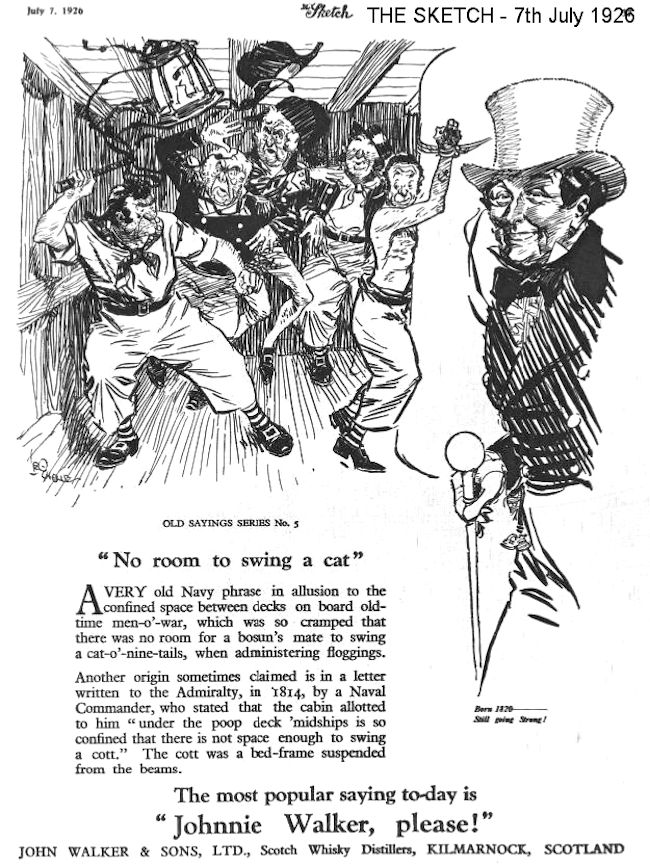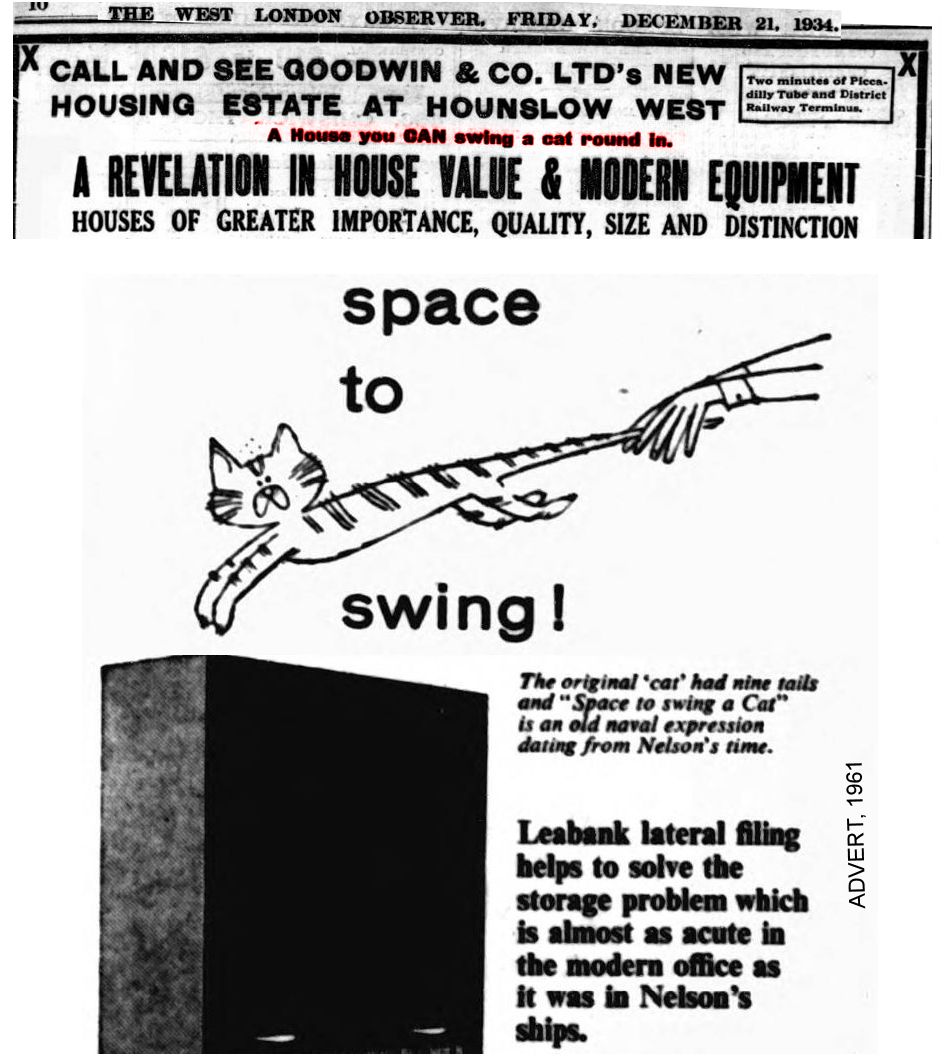
NO ROOM TO SWING A CAT
There are multiple derivations offered for this saying, which means a confined space, and the most popular explanation is that it is of nautical origin and refers to the “cat” or “flogger” used for punishment. However, a longer version of the saying is unambiguously about felines: "no room to swing a cat without getting fur in your mouth.” We may possibly have a soft-hearted (when it came to animals) Dr Johnsons to thank for the “cat o’nine-tails” explanation, because there are plenty of references to the activity involving a real cat.
A BARBARIC SPORT
"No room to swing a cat" might relate to the cruel sport of roping two cats together by their tails and slinging them over a branch to fight. ‘According a correspondent of the “Academy,” the phrase “Not room to swing a cat arose from the sport of swinging a cat to the branch a tree, as a mark to be shot at. Shakespeare refers to another variety of the sport; the cat being enclosed in a leathern bottle, was suspended a tree to be shot at. “Hang me in a bottle like a cat (Much Ado About Nothing.”)’ (Lancashire Evening Post, 6th February 1905) This popular and barbaric amusement has thankfully been overtaken by clay pigeon shooting.
A HANGING
“Cat" is an old Scottish word meaning a rogue, in which case "swing a cat" referred to the judicial hanging of a condemned criminal. While you might swing a criminal at the end of a rope, this explanation has no apparent link to the amount of space required.
NAUTICAL CONNECTIONS
“The Doctor [Doctor Johnson] thinks that when we speak of not having room to ‘swing a cat’ we mean, or ought to mean, the cat o’-nine-tails. ‘This connection, the editor thinks preferable to the notion that cat here means the animal so named.’ “(Glasgow Evening Citizen, Tuesday 8th July 1879). The same article mentions that the term “cat o’-nine-tails” was already familiar in 1702.
Hence it is popularly believed to refer to the compact cat (o-nine-tails), a flogger used on ships and to date back to Nelson’s time. “Sir,—Any old ‘salt’ will tell you that the phrase ‘not room to swing a cat’ is used to describe any confined space like the between decks in one of the old men of war - Britain’s wooden walls of one hundred years ago – where the bo’sun’s mate had not room to swing the cat-o’-nine-tails.” – B.L. (St James's Gazette, Tuesday 7th February 1905) When there was not enough room below to "swing the cat," the miscreant was taken on deck to be flogged.
Another explanation is that "no room to swing a cat" was an old nautical term referring to manoeuvring a compact merchant vessel known as a "cat" in a dock or narrow waterway by the use of mooring ropes. The arm that projects from a tower or similar to hoist things up is known as a "cathead" and in confined spaces, there would certainly be no room to swing this arm. ‘A sailor can pray, Sir, and it matters not, so he right, whether it is a matted pew at church, or swinging like a cat at the mast head.’ (Oxford University and City Herald, Saturday 26th July 1823, taken from the last Literary Gazette.)
Another source tells us ‘By far the more likely origin is that the word "cat" originally meant "cot." A sailor spending night ashore at a boarding or lodging house would be given a small room and he would later complain that there was not enough room to swing a "cot," a sailor's hammock. Smollett used the phrase in "Humphrey Clinker," but probably in connection with the tormenting of cats by the ignorant who in those days associated our household pet with witches.’ (Western Daily Press, Monday 5th January 1949)

SWINGING A REAL CAT
A very plausible origin for "no room to swing a cat" is mentioned in Peter Ackroyd's book "London, The Biography". During the late 19th and early 20th centuries in Whitechapel, when a family moved home it was customary to swing the family cat around one room of their new home to deter it from running away (much like wiping a cat's feet with butter in other folklore). In this case, the cat was presumably swung around in the owner’s arms to give it a view of the room. Being a poor area of London, many families would have ended up in homes where there wouldn't be any room to swing the cat. Ackroyd’s source is “Magic in Modern London” by Edward Lovett in 1925.
I started digging into this and found that "swinging a cat by the tail" was a cruel, but popular, amusement documented in newspapers as far back as the 1820s, and that references to not having enough room to swing a cat really did refer to swinging a cat, by its tail, at arm's length. “Why the extent of this domain will barely allow a man to swing a cat round by the tail, without scratching out her eyes against other people fence.” (Westmorland Gazette, Saturday 8th April 1826). Other early references in newspapers referred to swinging a cat against something in order to kill it; many of these cases ended up in the Police Court
.
“On board a man-of-war there is little enough of space at the best of times, and when she goes to sea she is usually crammed with provisions and water, so as not to leave room below to 'swing a cat by the tail,' much less to furnish cages for half a dozen or more Newgate birds,”(Morning Post, Friday 4th December 1829)
There is also this a paragraph from the Wrexham Advertiser of Saturday 17th January 1857: “. . . children who return home to sleep, eat, etc, . . . in a space in which the rotatory motion, commonly known as the ‘swinging of a cat’ could not for want of space be accomplished.” Admittedly we don’t know if this refers to swinging the poor creature by the tail or giving it a turn around the room in one’s arms. Another reference from 1857 indicated it is a real cat. “Mr. Pugh had, however, first of all, found fault with the house for being too small, and he believed that Mrs. Pugh said that there was not room enough in the house to swing a cat round.” (London Evening Standard, Wednesday 2nd December 1857)
“So limited is this fixture in size and shape that to measure it by the popular rule of swinging a cat therein, would, we apprehend, be highly injurious both to the animal swinging and the animal being swung.” (Bell’s Weekly Messenger, Saturday 15th December 1860) and “This important portion of the premises is so small that the most enthusiastic votary of that singular and much-talked-of amusement, swinging a cat, would never, in his wildest moments dream of indulging in his favourite pastime in so restricted a space.” (Coventry Herald, Friday 14th June 1861)
“. . . make them content with their ‘inevitable situation’ of living in a sitting room where there was not room to swing a cat. The space that was required to swing a cat must depend upon the length of the cat’s tail, and the length of the man’s arm that swung it.” (Salisbury and Winchester Journal, Saturday 26th December 1868)
“. . . miserable little rooms, some of them mere pill-boxes, in which, as a venerable lady of my acquaintance remarks, there is not half enough space to perform the feat of swinging a cat round by the tail.” (Croydon Advertiser and East Surrey Reporter, Saturday 22nd July 1876)
“The amusement of swinging a cat by the tail in the yards attached to some of the new houses can only be indulged in by the possessors of Manx cats.” (Sheffield Independent, Tuesday 2nd September 1890)

CONCLUSION
On balance, it seems likely that “not room to swing a cat” did involve a real cat just as often as it involved a flogger.